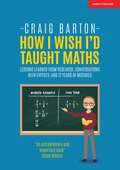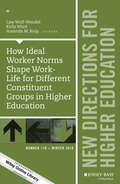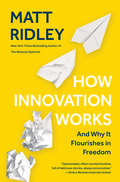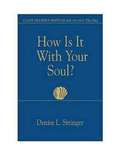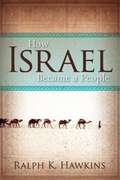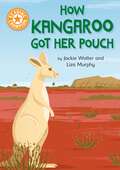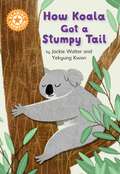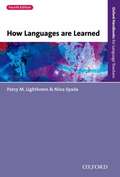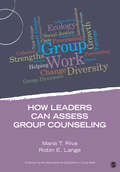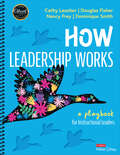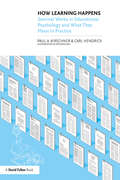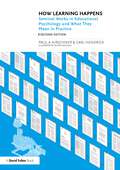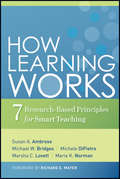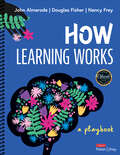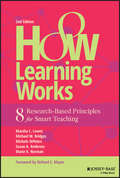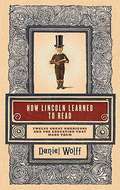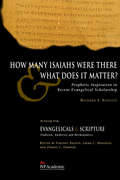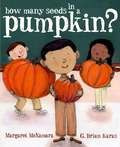- Table View
- List View
How I Wish I Had Taught Maths: Reflections on research, conversations with experts, and 12 years of mistakes
by Craig Barton"I genuinely believe I have never taught mathematics better, and my students have never learned more. I just wish I had known all of this twelve years ago."Craig Barton is one of the UK's most respected teachers of mathematics. In his remarkable new book, he explains how he has delved into the world of academic research and emerged with a range of simple, practical, effective strategies that anyone can employ to save time and energy and have a positive impact on the long-term learning and enjoyment of students. Craig presents the findings of over 100 books and research articles from the fields of Cognitive Science, Memory, Psychology and Behavioural Economics, together with the conversations he has had with world renowned educational experts on his Mr Barton Maths Podcast, and subsequent experiments with my students and colleagues.
How I Wish I Had Taught Maths: Reflections on research, conversations with experts, and 12 years of mistakes
by Craig Barton"I genuinely believe I have never taught mathematics better, and my students have never learned more. I just wish I had known all of this twelve years ago."Craig Barton is one of the UK's most respected teachers of mathematics. In his remarkable new book, he explains how he has delved into the world of academic research and emerged with a range of simple, practical, effective strategies that anyone can employ to save time and energy and have a positive impact on the long-term learning and enjoyment of students. Craig presents the findings of over 100 books and research articles from the fields of Cognitive Science, Memory, Psychology and Behavioural Economics, together with the conversations he has had with world renowned educational experts on his Mr Barton Maths Podcast, and subsequent experiments with my students and colleagues.
How Ideal Worker Norms Shape Work-Life for Different Constituent Groups in Higher Education: New Directions for Higher Education, Number 176 (J-B HE Single Issue Higher Education)
by Kelly Ward Lisa Wolf-WendelWork and family concerns are increasingly on the radar of colleges and universities. These concerns emerge out of workplace norms suggesting that for employees and students to be successful, they must be “ideal workers”.This volume explores work norms in higher education, focusing on the ways that employees and students interpret and experience ideal worker expectations in light of family responsibilities. Chapters address how the ideal worker norms vary for tenured and non-tenure track faculty, administrators, undergraduate and graduate students, and offers recommendations for modifying work norms to promote work-family balance for all constituents.This is the 176th volume of the Jossey-Bass quarterly report series New Directions for Higher Education. Addressed to presidents, vice presidents, deans, and other higher education decision makers on all kinds of campuses, it provides timely information and authoritative advice about major issues and administrative problems confronting every institution.
How Innovation Works: And Why It Flourishes in Freedom
by Matt RidleyBuilding on his national bestseller The Rational Optimist, Matt Ridley chronicles the history of innovation, and how we need to change our thinking on the subject.Innovation is the main event of the modern age, the reason we experience both dramatic improvements in our living standards and unsettling changes in our society. Forget short-term symptoms like Donald Trump and Brexit, it is innovation that will shape the twenty-first century. Yet innovation remains a mysterious process, poorly understood by policy makers and businessmen alike.Matt Ridley argues that we need to see innovation as an incremental, bottom-up, fortuitous process that happens as a direct result of the human habit of exchange, rather than an orderly, top-down process developing according to a plan. Innovation is crucially different from invention, because it is the turning of inventions into things of practical and affordable use to people. It speeds up in some sectors and slows down in others. It is always a collective, collaborative phenomenon, involving trial and error, not a matter of lonely genius. It happens mainly in just a few parts of the world at any one time. It still cannot be modeled properly by economists, but it can easily be discouraged by politicians. Far from there being too much innovation, we may be on the brink of an innovation famine.Ridley derives these and other lessons from the lively stories of scores of innovations, how they started and why they succeeded or failed. Some of the innovation stories he tells are about steam engines, jet engines, search engines, airships, coffee, potatoes, vaping, vaccines, cuisine, antibiotics, mosquito nets, turbines, propellers, fertilizer, zero, computers, dogs, farming, fire, genetic engineering, gene editing, container shipping, railways, cars, safety rules, wheeled suitcases, mobile phones, corrugated iron, powered flight, chlorinated water, toilets, vacuum cleaners, shale gas, the telegraph, radio, social media, block chain, the sharing economy, artificial intelligence, fake bomb detectors, phantom games consoles, fraudulent blood tests, hyperloop tubes, herbicides, copyright, and even life itself.
How Is It With Your Soul Class Leader: Class Leader's Manual for Use With This Day
by Denise L. StringerHow Is It With Your Soul? is a manual that serves as the twenty-first-century Class Leader's bible. The manual contains all the information needed to be an effective Class Leader in the Wesleyan tradition. Sections in the manual are devoted to: establishing and maintaining the classical Wesleyan Class Meeting, practicing effective group dynamics, growing spiritually as a Class Leader, engaging in Christian Conferencing, understanding and cultivating the relationship shared between the Class Leader and the pastor, and appreciating the duties and appropriate boundaries to be maintained by the Class Leader. How Is It With Your Soul? is not a textbook for a course of study or instructions for teaching a time-limited program, rather it is an indispensable tool that provides practical guidance and direction for the person committed to learning and practicing ministry as a Class Leader.
How Is It With Your Soul: Director's Guide for Use With This Day (How Is It With Your Soul)
by Denise StringerHow Is It With Your Soul? is a complete, stand-alone session guide for use by pastors and directors of Wesleyan Class Meeting groups to train Class Leaders. The ten training sessions are designed to create group support among the Class Leaders and also strengthen the relationship between the pastor or director and the Class Leaders they oversee. Dr. Denise Stringer, author of How Is It With Your Soul?, developed the Director's Guide for use in providing a training seminar for Class Leaders while in the process of training Class Leaders in her own congregation.
How Israel Became a People
by Ralph K. HawkinsHow did Israel become a people? Is the biblical story accurate? In what sense, if any, is the biblical story true? Are the origins of these ancient people lost in myth or is there hope to discovering who they were and how they lived? These questions divide students and scholars alike.While many believe the "Conquest" is only a fable, this book will present a different view. Using biblical materials and the new archaeological data, this title tells how the ancient Israelites settled in Canaan and became the people of Israel.The stakes for understanding the history of ancient Israel are high. The Old Testament tells us that Yahweh led the Hebrews into the land of Canaan and commanded them to drive its indigenous inhabitants out and settle in their place. This account has often served as justification for the possession of the land by the modern state of Israel. Archaeology is a "weapon" in the debate, used by both Israelis and Palestinians trying to write each other out of the historical narrative. This book provides needed background for the issues and will be of interest to those concerned with the complexity of Arab-Israeli relations.
How It's Being Done: Urgent Lessons from Unexpected Schools
by Pedro Noguera Karin ChenowethHow It's Being Done offers much-needed help to educators, providing detailed accounts of the ways in which unexpected schools--those with high-poverty and high-minority student populations--have dramatically boosted student achievement.How It's Being Done builds on Karin Chenoweth's widely hailed earlier volume, "It's Being Done," providing specific information about how such schools have exceeded expectations and met with unprecedented levels of success.
How It's Being Done: Urgent Lessons from Unexpected Schools
by Karin ChenowethHow It&’s Being Done offers much-needed help to educators, providing detailed accounts of the ways in which unexpected schools—those with high-poverty and high-minority student populations—have dramatically boosted student achievement.How It&’s Being Done builds on Karin Chenoweth&’s widely hailed earlier volume, &“It&’s Being Done,&” providing specific information about how such schools have exceeded expectations and met with unprecedented levels of success.
How Kangaroo Got Her Pouch: Independent Reading Orange 6 (Reading Champion #1076)
by Jackie WalterThis story is part of Reading Champion, a series carefully linked to book bands to encourage independent reading skills, developed with Dr Sue Bodman and Glen Franklin of UCL Institute of Education (IOE)Reading Champion offers independent reading books for children to practise and reinforce their developing reading skills.Fantastic, original stories are accompanied by engaging artwork and a reading activity. Each book has been carefully graded so that it can be matched to a child's reading ability, encouraging reading for pleasure. Perfect for 5-7 year olds or those reading book band orange.
How Koala Got a Stumpy Tail: Independent Reading Orange 6 (Reading Champion #1076)
by Jackie WalterThis story is part of Reading Champion, a series carefully linked to book bands to encourage independent reading skills, developed with Dr Sue Bodman and Glen Franklin of UCL Institute of Education (IOE)Reading Champion offers independent reading books for children to practise and reinforce their developing reading skills.Fantastic, original stories are accompanied by engaging artwork and a reading activity. Each book has been carefully graded so that it can be matched to a child's reading ability, encouraging reading for pleasure. Perfect for 5-7 year olds or those reading book band orange.
How Languages Are Learned (Fourth Edition)
by Patsy M. Lightbown Nina SpadaWritten by experienced teacher trainers and language learning experts, Patsy Lightbown and Nina Spada, How Languages Are Learned relates the theories of first and second language acquisition to what actually goes on in the classroom. It uses activities to explore the practical implications of the ideas presented. Evaluations and case studies are included throughout the book so that you can see a practical context for the research ideas you are reading about. Many of these examples are taken directly from real second language classrooms. Now in its 4th edition, How Languages Are Learned is highly valued for the way it relates language acquisition theory to classroom teaching and learning and draws practical implications from research for the language classroom. It is widely used as a reference book on teacher training courses, and is for new and experienced practising teachers. New to this editionUpdated to reflect the most recent research in the field of second language teaching and learning Activities and Questions for Reflection personalise content and support critical thinkingExtra activities, study questions and videos available onlineNow also available as an ebook from Amazon, Kobo and iBookstore
How Languages Work: An Introduction to Language and Linguistics
by Carol GenettiLanguage is a sophisticated tool which we use to communicate in a multitude of ways. Updated and expanded in its second edition, this book introduces language and linguistics - presenting language in all its amazing complexity while systematically guiding you through the basics. The reader will emerge with an appreciation of the diversity of the world's languages, as well as a deeper understanding of the structure of human language, the ways it is used, and its broader social and cultural context. <p><p>Part I is devoted to the nuts and bolts of language study - speech sounds, sound patterns, sentence structure, and meaning - and includes chapters dedicated to the functional aspects of language: discourse, prosody, pragmatics, and language contact. The fourteen language profiles included in Part II reveal the world's linguistic variety while expanding on the similarities and differences between languages. <p><p>Using knowledge gained from Part I, the reader can explore how language functions when speakers use it in daily interaction. With a step-by-step approach that is reinforced with well-chosen illustrations, case studies, and study questions, readers will gain understanding and analytical skills that will only enrich their ongoing study of language and linguistics.
How Leaders Can Assess Group Counseling (Group Work Practice Kit)
by Robin E. Lange Maria T. RivaA practical guide to evaluating group process and outcomes Ample evidence demonstrates that well-planned and delivered group work can benefit members. Equally important is the continual improvement of group work practice, achieved through the evaluation of each individual group experience. How to Evaluate Groups provides practical guidance on how you can establish—or collaborate with researchers to accomplish—research designs aimed at evaluating group process and outcomes. This accessible book: Covers group work measures, including both quantitative and qualitative approaches Includes tips on implementing research designs Draws from an up-to-date scholarly base that includes the latest research on group work How to Evaluate Groups is part of the Group Work Practice Kit: Improving the Everyday Practice of Group Work, a collection of nine books each authored by scholars in the specific field of group work. To promote a consistent reading experience, the books in the collection conform to editor Robert K. Conyne’s outline. Designed to provide practitioners, instructors, students, and trainees with concrete direction for improving group work, the series provides thorough coverage of the entire span of group work practice. This book is endorsed by the Association for Specialists in Group Work.
How Leadership Works: A Playbook for Instructional Leaders
by Douglas Fisher Nancy Frey Dominique B. Smith Cathy J. LassiterSharpen your instructional leadership skills and guide your school toward equity and excellence for all. Just think about how great schools could be if every instructional leader exercised their influence to create change—maximizing the efforts of others and mobilizing those efforts to work toward a shared goal. How Leadership Works: A Playbook for Instructional Leaders walks educators through the processes of clarifying, articulating, and actualizing instructional leadership goals with the aim of delivering on the promise of equity and excellence for all. Grounded in Visible Learning® research, the exercises in this easy-to-use playbook illuminate the essential mindframes necessary for effective instructional leadership and prompt veteran, new, and aspiring educators to identify challenges and determine next steps. It includes: Ten essential mindframes for leaders, together with the leadership practices that illustrate each mindframe in action Teaching practices, such as teacher clarity or student engagement in learning, that support teachers in delivering quality instruction, along with tools to document the impact of those practices on learning Strategies for leading learning, including establishing school culture, utilizing feedback, and supporting professional learning communities as a pathway to building collective teacher efficacy. Tools for applying the principles of change, conducting an initiative inventory, and implementing and de-implementing initiatives Exercise-by-exercise, educators and front office staff will deepen their knowledge, frame their priorities and practices, and gain new tools for supporting the instructional focus and initiatives designed to support learning at your school.
How Leadership Works: A Playbook for Instructional Leaders
by Douglas Fisher Nancy Frey Dominique B. Smith Cathy J. LassiterSharpen your instructional leadership skills and guide your school toward equity and excellence for all. Just think about how great schools could be if every instructional leader exercised their influence to create change—maximizing the efforts of others and mobilizing those efforts to work toward a shared goal. How Leadership Works: A Playbook for Instructional Leaders walks educators through the processes of clarifying, articulating, and actualizing instructional leadership goals with the aim of delivering on the promise of equity and excellence for all. Grounded in Visible Learning® research, the exercises in this easy-to-use playbook illuminate the essential mindframes necessary for effective instructional leadership and prompt veteran, new, and aspiring educators to identify challenges and determine next steps. It includes: Ten essential mindframes for leaders, together with the leadership practices that illustrate each mindframe in action Teaching practices, such as teacher clarity or student engagement in learning, that support teachers in delivering quality instruction, along with tools to document the impact of those practices on learning Strategies for leading learning, including establishing school culture, utilizing feedback, and supporting professional learning communities as a pathway to building collective teacher efficacy. Tools for applying the principles of change, conducting an initiative inventory, and implementing and de-implementing initiatives Exercise-by-exercise, educators and front office staff will deepen their knowledge, frame their priorities and practices, and gain new tools for supporting the instructional focus and initiatives designed to support learning at your school.
How Learning Happens: Seminal Works in Educational Psychology and What They Mean in Practice
by Carl Hendrick Paul A. KirschnerHow Learning Happens introduces 28 giants of educational research and their findings on how we learn and what we need to learn effectively, efficiently, and enjoyably. Many of these works have inspired researchers and teachers all around the world and have left a mark on how we teach today. Exploring 28 key works on learning and teaching, chosen from the fields of educational psychology and cognitive psychology, the book offers a roadmap of the most important discoveries in how learning happens. Each chapter examines a different work and explains its significance before describing the research, its implications for practice, how it can be used in the classroom and the key takeaways for teachers. Clearly divided into six sections, the book covers: How the brain works and what this means for learning and teaching Prerequisites for learning How learning can be supported Teacher activities Learning in context Cautionary tales and the ten deadly sins of education. Written by two leading experts and illustrated by Oliver Caviglioli, this is essential reading for teachers wanting to fully engage with and understand educational research as well as undergraduate students in the fields of education, educational psychology and the learning sciences.
How Learning Happens: Seminal Works in Educational Psychology and What They Mean in Practice
by Carl Hendrick Paul A. KirschnerHow Learning Happens introduces 32 giants of educational research and their findings on how we learn and what we need to know to learn effectively, efficiently, and enjoyably. Many of these works have inspired researchers and teachers all around the world and have left a mark on how we teach today.Now updated to include a new section on Memory and Cognition with five new chapters, this revised second edition explores a selection of the key works on learning and teaching, chosen from the fields of educational psychology and cognitive psychology. It offers a roadmap of the most important discoveries in the way learning happens, with each chapter examining a different work and explaining its significance before describing the research, its implications for practice, and how it can be used in the classroom – including the key takeaways for teachers.Clearly divided into seven sections, the book covers: Memory and cognition How the brain works Prerequisites for learning How learning can be supported Teacher activities Learning in context Cautionary tales Written by two leading experts and illustrated by Oliver Caviglioli, this is essential reading for teachers wanting to fully engage with and understand educational research as well as undergraduate students in the fields of education, educational psychology, and the learning sciences.
How Learning Works
by Marsha C. Lovett Richard E. Mayer Michael W. Bridges Marie K. Norman Michele Dipietro Susan A. AmbroseDistilling the research literature and translating the scientific approach into language relevant to a college or university teacher, this book introduces seven general principles of how students learn. The authors have drawn on research from a breadth of perspectives (cognitive, developmental, and social psychology; educational research; anthropology; demographics; organizational behavior) to identify a set of key principles underlying learning, from how effective organization enhances retrieval and use of information to what impacts motivation. Integrating theory with real-classroom examples in practice, this book helps faculty to apply cognitive science advances to improve their own teaching.
How Learning Works: A Playbook
by Douglas Fisher Nancy Frey John T. AlmarodeTranslate the science of learning into strategies for maximum learning impact in your classroom. The content, skills, and understandings students need to learn today are as diverse, complex, and multidimensional as the students in our classrooms. How can educators best create the learning experiences students need to truly learn? How Learning Works: A Playbook unpacks the science of how students learn and translates that knowledge into promising principles or practices that can be implemented in the classroom or utilized by students on their own learning journey. Designed to help educators create learning experiences that better align with how learning works, each module in this playbook is grounded in research and features prompts, tools, practice exercises, and discussion strategies that help teachers to Describe what is meant by learning in the local context of your classroom, including identifying any barriers to learning. Adapt promising principles and practices to meet the specific needs of your students—particularly regarding motivation, attention, encoding, retrieval and practice, cognitive load and memory, productive struggle, and feedback. Translate research on learning into learning strategies that accelerate learning and build students’ capacity to take ownership of their own learning—such as summarizing, spaced practice, interleaved practice, elaborate interrogation, and transfer strategies. Generate and gather evidence of impact by engaging students in reciprocal teaching and effective feedback on learning. Rich with resources that support the process of parlaying scientific findings into classroom practice, this playbook offers all the moves teachers need to design learning experiences that work for all students!
How Learning Works: A Playbook
by Douglas Fisher Nancy Frey John T. AlmarodeTranslate the science of learning into strategies for maximum learning impact in your classroom. The content, skills, and understandings students need to learn today are as diverse, complex, and multidimensional as the students in our classrooms. How can educators best create the learning experiences students need to truly learn? How Learning Works: A Playbook unpacks the science of how students learn and translates that knowledge into promising principles or practices that can be implemented in the classroom or utilized by students on their own learning journey. Designed to help educators create learning experiences that better align with how learning works, each module in this playbook is grounded in research and features prompts, tools, practice exercises, and discussion strategies that help teachers to Describe what is meant by learning in the local context of your classroom, including identifying any barriers to learning. Adapt promising principles and practices to meet the specific needs of your students—particularly regarding motivation, attention, encoding, retrieval and practice, cognitive load and memory, productive struggle, and feedback. Translate research on learning into learning strategies that accelerate learning and build students’ capacity to take ownership of their own learning—such as summarizing, spaced practice, interleaved practice, elaborate interrogation, and transfer strategies. Generate and gather evidence of impact by engaging students in reciprocal teaching and effective feedback on learning. Rich with resources that support the process of parlaying scientific findings into classroom practice, this playbook offers all the moves teachers need to design learning experiences that work for all students!
How Learning Works: Eight Research-Based Principles for Smart Teaching
by Marsha C. Lovett Michael W. Bridges Marie K. Norman Susan A. Ambrose Michele DiPietroApply these eight learning principles for more effective teaching As educators in the ever-evolving landscape of higher education, we are continuously challenged to keep our courses effective, engaging, relevant, and inclusive. The updated and expanded second edition of How Learning Works can help! It incorporates the latest research, provides a wider range of strategies, and adds a new principle to your toolkit. Readers will find eight essential learning principles that distill the overwhelming research literature into: Real-world teaching and learning scenarios Examples that reflect a diverse set of teaching environments and learner populations 150 practical strategies you can apply to your teaching context With these practical, broadly applicable insights, you can: Understand why your successful teaching approaches work Solve common teaching and learning problems Adapt your teaching to new modalities (e.g., online, hybrid) and challenges Ground your innovations in evidence-based practice Based on research from cognitive psychology, developmental psychology, education, anthropology, and more—this book makes learning work…for you and your students.
How Lincoln Learned to Read: Twelve Great Americans and the Educations That Made Them
by Daniel WolffBeginning with Benjamin Franklin and ending with Elvis Presley, author Daniel Wolff creates a series of intimate, interlocking profiles of notable Americans that track the nations developing notion of what it means to get a good education.
How Many Isaiahs Were There and What Does It Matter?: Prophetic Inspiration in Recent Evangelical Scholarship (Wheaton Theology Conference Series)
by Richard L. SchultzEvangelicals Scripture: Tradition, Authority and Hermeneutics
How Many Seeds in a Pumpkin?
by Margaret Mcnamara"How many seeds in a pumpkin?" Mr. Tiffin asks his class as they gather around the big, medium, and small pumpkins on his desk. Robert, the biggest kid, guesses that the largest one has a million seeds; Elinor, sounding like she knows what she's talking about, guesses the medium one has 500 seeds; and Anna, who likes even numbers better than odd ones, guesses that the little one has 22. Charlie, the smallest boy in the class, doesn't have a guess. Counting pumpkin seeds is messy business, but once the slimy job is done, to everyone's surprise, the smallest pumpkin has the most seeds! As Charlie happily exclaims, "Small things have a lot going on inside of them."
